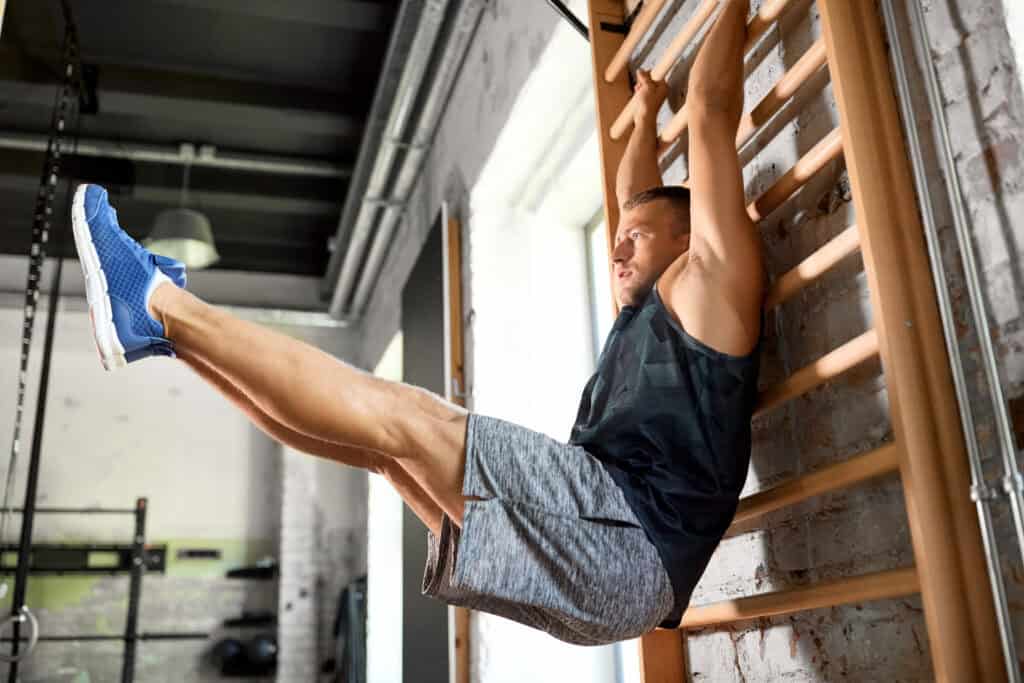Core strength is the foundation of a well-rounded fitness program. A strong core stabilizes the spine, supports balance, and enables efficient movement across a wide range of exercises. In everyday life and in sports, the core is engaged in nearly every motion, from standing up to lifting objects or jumping and sprinting. Strengthening core muscles can help prevent injury, improve posture, and enhance performance across all types of physical activities.
Electromyography (EMG) studies, which measure muscle activation, have shown that certain exercises can target the core more effectively than others, helping individuals build core strength in a focused and efficient way. The four Jefit core exercises featured here—medicine ball overhead slam, barbell kneeling rollout, hanging ab exercises, and plank with shoulder taps—are proven to activate multiple core muscles and deliver strength and stability improvements.
1. Medicine Ball Overhead Slam
The medicine ball overhead slam is a dynamic, explosive movement that engages the entire core, particularly the rectus abdominis and obliques. To perform this exercise, stand with feet shoulder-width apart, hold a medicine ball overhead, and use your core muscles to drive the ball down toward the ground with force.
EMG Insights: According to research by Snarr et al. (2016) published in the Journal of Strength and Conditioning Research, overhead slams with a medicine ball exhibit high rectus abdominis activation, particularly when performed with high intensity. The explosive nature of the slam enhances core engagement, as the trunk must contract forcefully to control the ball’s momentum and impact.
Benefits: The medicine ball overhead slam improves power and coordination in addition to core strength. Its ballistic nature makes it a great option for athletes aiming to improve rotational strength and dynamic stability.
2. Barbell Kneeling Rollout Exercise
The barbell kneeling rollout is an advanced core exercise that requires significant control and strength. To perform, start in a kneeling position with hands gripping a barbell in front of you. Roll the barbell forward, extending your arms and hips, and then use your core to pull the barbell back to the starting position.
EMG Insights: A study by Escamilla et al. (2010) in the Journal of Orthopaedic & Sports Physical Therapy found that the rollout exercise recruits deep core stabilizers, particularly the transverse abdominis and erector spinae, to maintain spinal alignment and control the movement. This exercise produces high levels of core activation, especially in the eccentric (lengthening) phase.
Benefits: The barbell kneeling rollout improves core stability and endurance, which are critical for preventing lower back injuries. It also enhances control and coordination, as the deep core muscles work in harmony to stabilize the spine.

3. Hanging Ab Exercises
Hanging ab exercises, such as hanging leg raises, are highly effective for targeting the lower abdominals and hip flexors. To perform, hang from a pull-up bar with your arms fully extended and then lift your legs toward your chest, engaging the core and maintaining control.
EMG Insights: Studies, including one by Guimaraes et al. (2001) in the European Journal of Applied Physiology, highlight that hanging leg raises elicit substantial muscle activation in the lower rectus abdominis and external obliques. EMG data show that the hanging position forces the lower abdominals to stabilize the pelvis, which increases muscle activation levels compared to ground-based exercises.
Benefits: Hanging ab exercises build core strength while challenging grip strength and upper body endurance. The emphasis on lower abdominal muscles makes it one of the best exercises for individuals looking to develop a balanced core.
4. Plank with Shoulder Taps
The plank with shoulder taps is a variation of the classic plank that introduces an added challenge for stability and core control. Begin in a high plank position and, while keeping your body stable, lift one hand to tap the opposite shoulder, alternating sides.
EMG Insights: Research by Santana et al. (2013) published in the Journal of Sports Medicine and Physical Fitness shows that shoulder tap planks engage the obliques and transverse abdominis extensively, as the core works to resist rotation and stabilize the body. The alternating arm movement demands greater muscle activation to maintain stability throughout the movement.
Benefits: This exercise promotes anti-rotational core strength, crucial for maintaining stability during unilateral movements. It also enhances shoulder stability and improves control over core engagement, making it suitable for beginners and advanced athletes alike.
EMG Research Overview on Core Muscle Activation
EMG research has provided valuable insights into the effectiveness of various core exercises. Studies generally indicate that exercises that require anti-rotational stability, like the plank with shoulder taps, engage the obliques and transverse abdominis more intensely. Meanwhile, exercises that involve dynamic movement, such as the medicine ball slam and hanging ab raises, excel at activating the rectus abdominis and lower abdominal regions. The barbell rollout, known for its high activation of deep core stabilizers, remains a top choice for developing core endurance and stability.
Conclusion: Incorporating High-Activation Core Exercises into Your Routine
Incorporating high-activation core exercises like the medicine ball overhead slam, barbell kneeling rollout, hanging ab exercises, and plank with shoulder taps can significantly enhance your core strength, stability, and endurance. Supported by EMG data, these exercises ensure that you’re working all major muscle groups within the core, creating a balanced and resilient midsection. By adding these exercises to your regular workout plan, you’ll enjoy improved performance across various physical activities, a reduced risk of injury, and a stronger, more stable core.
References
- Snarr, R. L., & Esco, M. R. (2016). Electromyographic Comparison of the Rectus Abdominis During a variety of Abdominal Exercises. Journal of Strength and Conditioning Research, 30(10), 2936-2941.
- Escamilla, R. F., et al. (2010). Core muscle activation during Swiss ball and traditional abdominal exercises. Journal of Orthopaedic & Sports Physical Therapy, 40(5), 265-276.
- Guimaraes, A. C., et al. (2001). The electromyographic activity of abdominal muscles in abdominal exercises. European Journal of Applied Physiology, 85(3-4), 274-278.
- Santana, J. C., et al. (2013). Comparison of Core Muscle Activation During Various Stability Exercises. Journal of Sports Medicine and Physical Fitness, 53(3), 258-264.
By integrating these Jefit core exercises into your workout routine, you’re investing in a stronger, healthier body that performs well in every facet of life.
Stay Strong Together
If you’re serious about nutrition, building muscle and reaching your fitness goals, the Jefit app is the perfect tool to help get you there. With over 20 million downloads and more than 12 million bodybuilders using the app to track their workouts, Jefit is the ultimate strength training companion. Rated as the 2023 Best App and featured by top publications like Men’s Health, PC Magazine, and USA TODAY. Jefit boasts 42,000+ five-star ratings for its user-friendly design and comprehensive features. Whether you’re focused on protein intake, building strength, or tracking your progress, Jefit has everything you need to succeed. Download Jefit today and join millions of fitness enthusiasts transforming their bodies!
- 8-Week Beginner Strength Training Plan - April 7, 2025
- How to Build and Maintain Muscle Mass as You Age - April 4, 2025
- Maximum Activation: Bear Crawl, Plank, & Dead Bug - April 2, 2025
